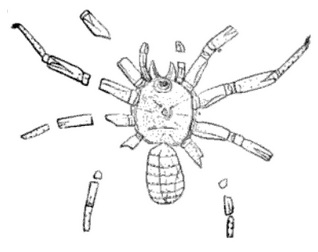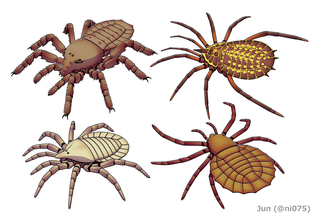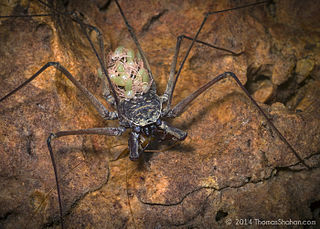
Amblypygi is an order of arachnid chelicerate arthropods also known as whip spiders or tailless whip scorpions. The name "amblypygid" means "blunt tail", a reference to a lack of the flagellum that is otherwise seen in whip scorpions. Amblypygids possess no silk glands or venomous fangs. They rarely bite if threatened, but can grab fingers with their pedipalps, resulting in thorn-like puncture injuries.

The Opiliones are an order of arachnids colloquially known as harvestmen, harvesters, harvest spiders, or daddy longlegs. As of April 2017, over 6,650 species of harvestmen have been discovered worldwide, although the total number of extant species may exceed 10,000. The order Opiliones includes five suborders: Cyphophthalmi, Eupnoi, Dyspnoi, Laniatores, and Tetrophthalmi, which were named in 2014.

Uropygi is an arachnid order comprising invertebrates commonly known as whip scorpions or vinegaroons. They are often called uropygids. The name "whip scorpion" refers to their resemblance to true scorpions and possession of a whiplike tail, and "vinegaroon" refers to their ability when attacked to discharge an offensive, vinegar-smelling liquid, which contains acetic acid. The order may also be called Thelyphonida. Both names, Uropygi and Thelyphonida, may be used either in a narrow sense for the order of whip scorpions, or in a broad sense which includes the order Schizomida.

Ricinulei is a small order of arachnids. Like most arachnids, they are predatory, eating small arthropods. They occur today in west-central Africa (Ricinoides) and the Americas as far north as Texas. As of 2021, 91 extant species of ricinuleids have been described worldwide, all in the single family Ricinoididae. In older works they are sometimes referred to as Podogona. Due to their obscurity they do not have a proper common name, though in academic literature they are occasionally referred to as hooded tickspiders.

The Mesothelae are a suborder of spiders that includes a single extant family, Liphistiidae, and a number of extinct families. This suborder is thought to form the sister group to all other living spiders, and to retain ancestral characters, such as a segmented abdomen with spinnerets in the middle and two pairs of book lungs. Members of Liphistiidae are medium to large spiders with eight eyes grouped on a tubercle. They are found only in China, Japan, and southeast Asia. The oldest known Mesothelae spiders are known from the Carboniferous, over 300 million years ago.

Arthrolycosidae is an extinct family of arachnids, possibly spiders. Fossils placed in the family were found in the Carboniferous to Permian, 359 to 252 million years ago. They were considered by Alexander Petrunkevitch to be "mesotheles", i.e. placed in the spider suborder Mesothelae. However, Paul A. Selden has stated they only have "the general appearance of spiders", with segmented abdomens (opisthosomae), but no definite spinnerets. At least some of the specimens placed in the family in the genus Arthrolycosa are considered to be spiders, whereas Eocteniza is "rather problematic as a spider".

Plesiosiro is an extinct arachnid genus known exclusively from nine specimens from the Upper Carboniferous of Coseley, Staffordshire, United Kingdom. The genus is monotypic, represented only by the species Plesiosiro madeleyi described by Reginald Innes Pocock in his important 1911 monograph on British Carboniferous arachnids. It is the only known member of the order Haptopoda.

The order Trigonotarbida is a group of extinct arachnids whose fossil record extends from the late Silurian to the early Permian. These animals are known from several localities in Europe and North America, as well as a single record from Argentina. Trigonotarbids can be envisaged as spider-like arachnids, but without silk-producing spinnerets. They ranged in size from a few millimetres to a few centimetres in body length and had segmented abdomens (opisthosoma), with the dorsal exoskeleton (tergites) across the backs of the animals' abdomens, which were characteristically divided into three or five separate plates. Probably living as predators on other arthropods, some later trigonotarbid species were quite heavily armoured and protected themselves with spines and tubercles. About seventy species are currently known, with most fossils originating from the Carboniferous coal measures.

Phalangiotarbida is an extinct arachnid order first recorded from the Early Devonian of Germany and most widespread in the Upper Carboniferous coal measures of Europe and North America. The last species are known from the early Permian Rotliegend of Germany.
Nemastomoides is an extinct genus of harvestmen known from the Carboniferous fossil record. The genus is the only member of the family Nemastomoididae and contains three described species. Nemastomoides elaveris was found in the Coal Measures of Commentry in northern France, together with Eotrogulus fayoli.
Anthidium exhumatum is an extinct species of mason bee in the Megachilidae genus Anthidium. The species is solely known from the late Eocene, Chadronian stage, Florissant Formation deposits in Florissant, Colorado, USA. Anthidium exhumatum is one of only four extinct species of mason bees known from the fossil record, and with Anthidium scudderi, one of two species from the Florissant Formation.

Phrynus is a genus of whip spiders found in tropical and subtropical regions, mostly in the new world.

Phrynus longipes is a species of amblypygid often found in the Caribbean. They are also found in other warm climate areas such as the forests of Central America. Within this region, however, Phrynus longipes lives in an array of habitats from caves to coastlines. They are protective of their territory, using their pedipalps to deter predators or unwanted visitors. Being nocturnal predators, they take shelter during the day and hunt primarily at night. Phrynus longipes feed on both vertebrates and invertebrates. They are the first amblypygid to be recorded feeding on an avian species.

Paraphrynus is a genus of whip spiders, also known as tailless whip scorpions, of the family Phrynidae. It is distributed from the southwestern United States to Central America, including several Caribbean islands. Most species are endemic to Mexico.

Phrynidae is a family of amblypygid arachnida arthropods also known as whip spiders and tailless whip scorpions. Phrynidae species are found in tropical and subtropical regions in North and South America. Some species are subterranean; all are nocturnal. At least some species of Phrynidae hold territories that they defend from other individuals.
Sarax is a genus of amblypygids of the family Charinidae.

Paracharon is a genus of tailless whip scorpion. A single species, Paracharon caecus has been described. It is endemic to Guinea-Bissau in West Africa It is one of two living genera of the family Paracharontidae, alongside the South American Jorottui. It is a troglobite having no eyes, with P. caecus found living in termite nests.

Paracharontidae is an arachnid family within the order Amblypygi. Paracharontidae and the extinct Weygoldtinidae from the Carboniferous form the suborder Paleoamblypygi, the sister group to the remaining Amblypygi. The family contains two genera: Paracharon, containing the single species Paracharon caecus Hansen, 1921 from Guinea-Bissau in West Africa, and Jorottui with the single species Jorottui ipuanai from Colombia in northern South America. Paracharonopsis from the Eocene (Ypresian) aged Cambay amber of India was initially assigned to this family but this was later questioned and it has since been reassigned to Euamblypygi. Both living species are troglobites, having no eyes, with P. caecus living in termite nests, while J. ipuanai inhabits caves.

Geralinura is an extinct genus in the family Thelyphonidae, commonly known as whip scorpions. Fossil evidence found in the midwestern United States and the United Kingdom indicates that this genus lived during the mid-to-late Carboniferous period. Unlike the subchelate pedipalps of modern whip scorpions, the pedipalps of Geralinura are spiked and non-chelate, suggesting that the modern trait evolved at a later point in time.



















